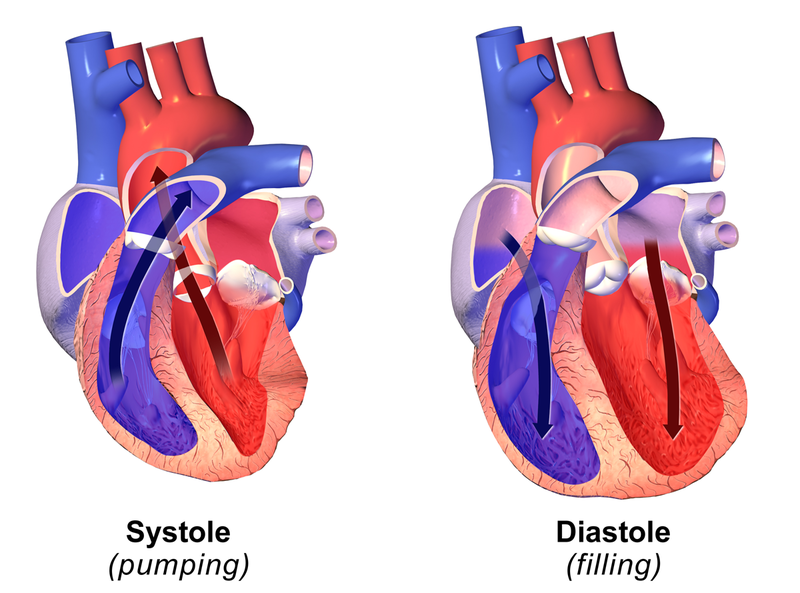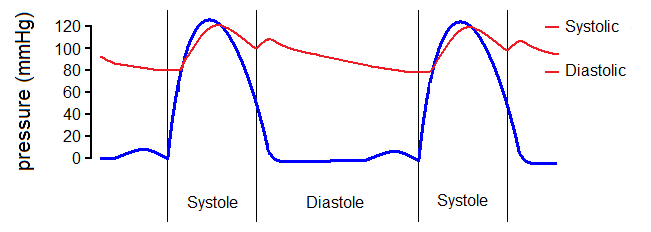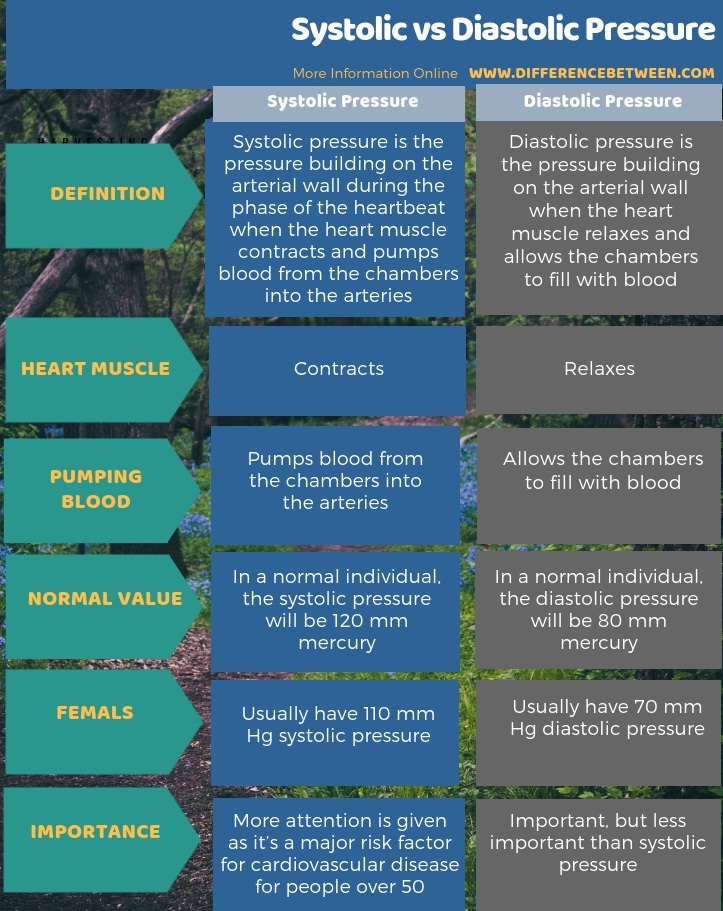Difference Between Systolic and Diastolic Pressure
The key difference between systolic and diastolic pressure is that systolic pressure is the pressure building on the arterial wall during the phase of the heartbeat when the heart muscle contracts and pumps blood from the chambers into arteries while diastolic pressure is the pressure building on the arterial wall when the heart muscle relaxes and allows the chambers to fill with blood.
Pressure is the word commonly used to refer to arterial blood pressure. The heart is the organ that acts as a pump to carry out the blood circulation throughout the body. When the heart pumps, the blood will enter the aorta with a force. When the pressurized blood enters the aorta it exerts pressure on its wall, and aorta has an elastic capacity to extend and distend a bit. After that, the heart will be relaxed again and the blood supply to the aorta stops and the valves at the beginning of aorta closes. At this time, the aorta comes back to the normal position from the distended position. Again, this recoiling will exert pressure on the blood.
CONTENTS
1. Overview and Key Difference
2. What is Systolic Pressure
3. What is Diastolic Pressure
4. Similarities Between Systolic and Diastolic Pressure
5. Side by Side Comparison – Systolic vs Diastolic Pressure in Tabular Form
6. Summary
What is Systolic Pressure?
Systolic pressure is one of the two values described in blood pressure. It is the pressure blood exerts against the artery walls when the heart beats. Heart muscles contract and the heart pumps blood to the aorta with a force. Then the blood exerts a pressure on the artery wall.

Figure 01: Systole vs Diastole
Normally, systolic pressure should be below 120 mm Hg in a healthy person. The systolic pressure may rise to a higher level during heavy work, situations where you feel fear, etc. However, these levels come back to normal with the rest. Low systolic pressure causes a condition called systolic hypotension, which can create lightheadedness, dizziness, syncope, or organ failure. The reason behind low systolic pressure can be too low blood volume, blood vessel weakness or dilation of the blood.
What is Diastolic Pressure?
Diastolic pressure is the second value indicated in the blood pressure. It is the pressure the blood exerts against the artery walls when the heart is resting or relaxing. Diastolic pressure occurs between heartbeats. At this point, the heart does not actively pump blood into arteries. It is the ventricular relaxation period and the preparation period for the next heart muscle contraction.

Figure 02: Systolic and Diastolic Pressure
Moreover, diastolic pressure of a healthy individual is 80 mm Hg or below.
What are the Similarities Between Systolic and Diastolic Pressure?
- Systolic and diastolic blood pressures represent the pressures within the blood vessels during different parts of the cardiac cycle.
- Both pressures vary depending on the individual’s activity.
- Besides, females may have less systolic and diastolic pressure.
- Also, children too have less systolic and diastolic pressure; however, it depends on their age and activity.
- Accurately measuring both these values is important in diagnosing and managing hypertension.
What is the Difference Between Systolic and Diastolic Pressure?
Systolic and diastolic pressure are two measurements that imply the blood pressure of an individual. Systolic pressure is the pressure the blood extends on the arterial walls when the heart muscles contracts and the heart pumps blood into arteries. In contrast, diastolic pressure is the pressure the blood extends on the arterial walls when the heart is relaxing in between heartbeats. So, this is the key difference between systolic and diastolic pressure.
When comparing these two values, systolic pressure is more important since it increases the risk of cardiovascular diseases. A healthy individual has 120 mm Hg systolic pressure and 80 mm Hg diastolic pressure. Therefore, we can consider this also as a difference between systolic and diastolic pressure.

Summary – Systolic vs Diastolic Pressure
Blood pressure is indicated in two values: systolic pressure and diastolic pressure. The systolic pressure is the pressure on the arterial wall during the heart muscle contraction. Diastolic pressure is the pressure when the heart is relaxing. In a healthy individual, the normal systolic pressure is 120 mm Hg while the diastolic pressure is 80 mm Hg. Elevated systolic and diastolic pressure values indicate the risk of cardiac diseases and hypertension. Thus, this summarizes the difference between systolic and diastolic pressure.
Reference:
1. Fogoros, Richard N. “Why Systolic and Diastolic Blood Pressure Are Both Important.” Verywell Health, Verywellhealth, 5 May 2019, Available here.
Image Courtesy:
1. “Systole vs Diastole” By BruceBlaus – Own work (CC BY-SA 4.0) via Commons Wikimedia
2. “Cardiac cycle pressure only” By Cardiac_Cycle_Left_Ventricle.PNG: DestinyQxderivative work: Physchim62 (talk) – Cardiac_Cycle_Left_Ventricle.PNG (CC BY-SA 2.5) via Commons Wikimedia
ncG1vNJzZmivp6x7pbXFn5yrnZ6YsqOx07CcnqZemLyue8OinZ%2Bdopq7pLGMm5ytr5Wau26%2F2KyrqKSZmHqiusNmm6KZo6m8rbXCZqernaOowrOxjg%3D%3D